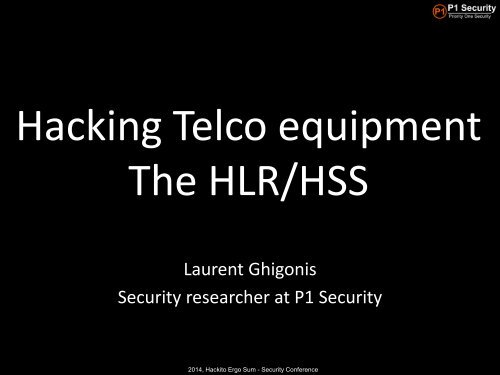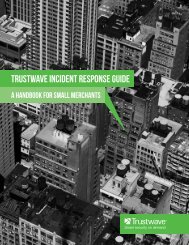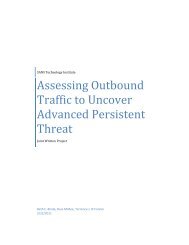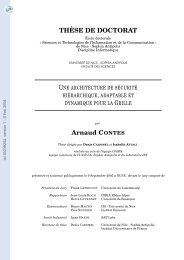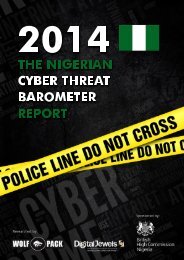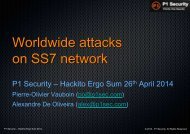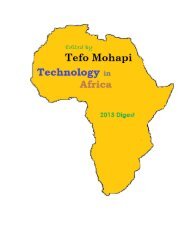day1_Hacking-telco-equipment-The-HLR-HSS-Laurent-Ghigonis-p1sec
day1_Hacking-telco-equipment-The-HLR-HSS-Laurent-Ghigonis-p1sec
day1_Hacking-telco-equipment-The-HLR-HSS-Laurent-Ghigonis-p1sec
Create successful ePaper yourself
Turn your PDF publications into a flip-book with our unique Google optimized e-Paper software.
<strong>Hacking</strong> Telco <strong>equipment</strong><br />
<strong>The</strong> <strong>HLR</strong>/<strong>HSS</strong><br />
<strong>Laurent</strong> <strong>Ghigonis</strong><br />
Security researcher at P1 Security<br />
2014, Hackito Ergo Sum - Security Conference
What are we talking about ?<br />
2014, Hackito Ergo Sum - Security Conference<br />
A mobile network operator Core Network<br />
Network passive capture showing Global Titles
Mobile Operators<br />
• Conveys the majority of voice communications<br />
worldwide<br />
• Conveys our data<br />
• Conveys growing M2M traffic<br />
• Emergency systems notifications uses it<br />
=> We now rely on it and we have some security<br />
expectations<br />
2014, Hackito Ergo Sum - Security Conference
Mobile Operators and governance<br />
• In Europe<br />
2014, Hackito Ergo Sum - Security Conference
Mobile Operators and governance<br />
• In France<br />
Lets check the reality …<br />
2014, Hackito Ergo Sum - Security Conference
<strong>The</strong> Witness : An <strong>HLR</strong>/<strong>HSS</strong><br />
AuC HSM<br />
<strong>HLR</strong> Front End<br />
<strong>HSS</strong> Front End<br />
Provisioning DSA<br />
Routing DSA<br />
Install Server<br />
Admin<br />
Provisioning Gateway<br />
3 Back Ends<br />
Typical <strong>HLR</strong>/<strong>HSS</strong> in use in operator Core Network<br />
2014, Hackito Ergo Sum - Security Conference
<strong>HLR</strong>/<strong>HSS</strong> in Mobile Core Network<br />
2014, Hackito Ergo Sum - Security Conference<br />
A mobile network operator Core Network<br />
Network passive capture showing Global Titles
<strong>HLR</strong>/<strong>HSS</strong> in Mobile Core Network<br />
2014, Hackito Ergo Sum - Security Conference
<strong>HLR</strong>/<strong>HSS</strong> in Mobile Core Network<br />
2014, Hackito Ergo Sum - Security Conference
<strong>HLR</strong>/<strong>HSS</strong> in Mobile Core Network<br />
• <strong>HLR</strong> is used in all 2G Operator Network<br />
• <strong>HSS</strong> is used in all 3G/4G Operator Network<br />
• Stores customer data<br />
– Subscriber identifier (IMSI)<br />
– Subscriber encryption keys<br />
– Subscriber approximate location<br />
– Subscriber SIM plan options<br />
• Critical to the operator<br />
– <strong>HLR</strong> down == Network down, no calls possible<br />
2014, Hackito Ergo Sum - Security Conference
<strong>HLR</strong>/<strong>HSS</strong> in Mobile Core Network<br />
<strong>HLR</strong>/<strong>HSS</strong> receiving subscriber location update<br />
from the operator SS7/Diameter signaling links<br />
2014, Hackito Ergo Sum - Security Conference
Lets make it talk …<br />
2014, Hackito Ergo Sum - Security Conference
2014, Hackito Ergo Sum - Security Conference
Plan<br />
<strong>HLR</strong>/<strong>HSS</strong> Robustness assessment<br />
• Virtualization<br />
– Virtualization and instrumentation<br />
• System Analysis<br />
– Localroot, Framework complexity<br />
• Network Fuzzing<br />
– SS7 Protocols<br />
• Binaries Reverse<br />
– More vulns<br />
2014, Hackito Ergo Sum - Security Conference
<strong>HLR</strong>/<strong>HSS</strong> Virtualization<br />
No, it’s not ATCA / NFV<br />
2014, Hackito Ergo Sum - Security Conference
An <strong>HLR</strong>/<strong>HSS</strong> is an ecosystem<br />
2014, Hackito Ergo Sum - Security Conference
An <strong>HLR</strong>/<strong>HSS</strong> is an ecosystem<br />
• <strong>HLR</strong> + <strong>HSS</strong> Front-end<br />
• <strong>HLR</strong> Administration server<br />
• Application/Database routing servers<br />
• <strong>HLR</strong> Backend/Database (multiple)<br />
• HSM (Hardware Security Module) for keys<br />
2014, Hackito Ergo Sum - Security Conference
<strong>HLR</strong>/<strong>HSS</strong> is never alone<br />
2014, Hackito Ergo Sum - Security Conference
Where to start<br />
• Most exposed from the outside<br />
=> <strong>HLR</strong>/<strong>HSS</strong> Front-end<br />
– Receives SS7/Diameter traffic<br />
• Telecom network stacks<br />
– Receives provisioning requests<br />
– Connected to the HSM<br />
2014, Hackito Ergo Sum - Security Conference
Where to start<br />
AuC HSM<br />
<strong>HLR</strong> Front End<br />
<strong>HSS</strong> Front End<br />
Provisioning DSA<br />
Routing DSA<br />
Install Server<br />
Admin<br />
Provisioning Gateway<br />
3 Back Ends<br />
Typical <strong>HLR</strong>/<strong>HSS</strong> in use in operator Core Network<br />
2014, Hackito Ergo Sum - Security Conference
Virtualization of <strong>HLR</strong>/<strong>HSS</strong><br />
Frontend<br />
2014, Hackito Ergo Sum - Security Conference
Original Equipment Manufacturer<br />
• Specs of the real <strong>equipment</strong><br />
– i386 / x64 / Sparc<br />
– Solaris / CentOS<br />
– 32 GB of RAM<br />
– CPU 16 Cores<br />
– TB hard drive + External SAN<br />
2014, Hackito Ergo Sum - Security Conference
Qemu/KVM<br />
• Faster than VirtualBox<br />
• More flexible<br />
• Tweak code to add more network interfaces<br />
• VDE Switch for networking<br />
2014, Hackito Ergo Sum - Security Conference
Qemu/KVM<br />
qemu-system-x86_64 \<br />
-machine type=pc,accel=kvm:tcg -pidfile ./myhlr.pid \<br />
-m 7.2g -smp 4 -drive file=/dev/mapper/lvm-vm--myhlr,cache=none \<br />
-vnc 127.0.0.1:2,password,tls,lossy -display curses -rtc base=localtime,driftfix=slew \<br />
-net vde,vlan=1,sock=/home/vm-kvm/myhlr/vde-myhlr.ctl -net nic,vlan=1,macaddr=52:54:00:00:10:01 \<br />
-net vde,vlan=2,sock=/home/vm-kvm/myhlr/vde-myhlr.ctl -net nic,vlan=2,macaddr=52:54:00:00:10:02 \<br />
-net vde,vlan=3,sock=/home/vm-kvm/myhlr/vde-myhlr.ctl -net nic,vlan=3,macaddr=52:54:00:00:10:02 \<br />
-net vde,vlan=4, sock=/home/vm-kvm/myhlr/vde-myhlr.ctl -net nic,vlan=4,macaddr=52:54:00:00:10:02 \<br />
-net vde,vlan=5,sock=/home/vm-kvm/myhlr/vde-myhlr.ctl -net nic,vlan=5,macaddr=52:54:00:00:10:02 \<br />
-net vde,vlan=6,sock=/home/vm-kvm/myhlr/vde-myhlr.ctl -net nic,vlan=6,macaddr=52:54:00:00:10:02 \<br />
-net vde,vlan=7,sock=/home/vm-kvm/myhlr/vde-myhlr.ctl -net nic,vlan=7,macaddr=52:54:00:00:10:02 \<br />
-net vde,vlan=8,sock=/home/vm-kvm/myhlr/vde-myhlr.ctl -net nic,vlan=8,macaddr=52:54:00:00:10:02 \<br />
-net vde,vlan=9,sock=/home/vm-kvm/myhlr/vde-myhlr.ctl -net nic,vlan=9,macaddr=52:54:00:00:10:02 \<br />
-net vde,vlan=10,sock=/home/vm-kvm/myhlr/vde-myhlr.ctl -net nic,vlan=10,macaddr=52:54:00:00:10:02 \<br />
-net vde,vlan=11,sock=/home/vm-kvm/myhlr/vde-myhlr.ctl -net nic,vlan=11,macaddr=52:54:00:00:10:02 \<br />
-net vde,vlan=12,sock=/home/vm-kvm/myhlr/vde-myhlr.ctl -net nic,vlan=12,macaddr=52:54:00:00:10:02<br />
• Physical partition for disk<br />
– Do not use disk file on host btrfs<br />
• super slow<br />
• ext4 is ok<br />
– http://www.linux-kvm.org/page/Tuning_KVM<br />
• Curses output<br />
• Improvements: serial terminal<br />
2014, Hackito Ergo Sum - Security Conference
Qemu/KVM<br />
• Solaris 10<br />
– Qemu/KVM ok for x64<br />
– Fails for SPARC<br />
• Stock kernel<br />
– /kernel<br />
– /usr/kernel<br />
• Custom kernel modules<br />
– For Telecom Signaling [Signalware]<br />
• Uses grub<br />
• Failsafe mode<br />
2014, Hackito Ergo Sum - Security Conference
Inside the machine<br />
• ZFS filesystem<br />
• Solaris 10<br />
• Everything is installed via packages<br />
• Multiple Oracle databases<br />
– Even on <strong>HLR</strong>/<strong>HSS</strong> Front-end only<br />
• A lot of Middleware framework to start the<br />
actual network stacks / applications<br />
• Telco stacks: based on Ulticom Signalware<br />
• <strong>The</strong> OS expects its precious network cards<br />
2014, Hackito Ergo Sum - Security Conference
System Analysis<br />
2014, Hackito Ergo Sum - Security Conference
<strong>The</strong> filesystem<br />
• ZFS = Filesystem + Volume manager<br />
• ZFS pool (often mirrored)<br />
– ZFS root pool<br />
• 100-200GB usually enough<br />
• Prepare free space for system/processes dump<br />
– ZFS Dump pool<br />
• Should be more than size of your RAM<br />
– ZFS SWAP pool<br />
• Should be more that size of your RAM<br />
2014, Hackito Ergo Sum - Security Conference
<strong>The</strong> filesystem<br />
• ZFS offers good resilience against data corruption,<br />
and is very picky when there is too much<br />
corruption<br />
– You can’t recover when filesystem is too much broken<br />
– You can try<br />
$ zdb -e -p /dev/dsk/c0t3d0p0 -F -X -AAA -dd rpool 1<br />
$ zpool import -f -F -X 19485729304958623456 mypool<br />
$ zpool import -o readonly=on -o autoreplace=on -o<br />
failmode-continue -m -N -f -F -X 19485729304958623456<br />
mypool<br />
• If it fails<br />
– Code your own tool by modifying ZOL<br />
http://zfsonlinux.org/<br />
2014, Hackito Ergo Sum - Security Conference
advdata/<br />
autoinstmnt/<br />
bin@<br />
boot/<br />
cust_data/<br />
dump@<br />
environment.txt*<br />
etc/<br />
export/<br />
false/<br />
global@<br />
home/<br />
installmnt/<br />
kernel/<br />
lib/<br />
mnt/<br />
net/<br />
nsr/<br />
opt/<br />
patchmnt/<br />
platform/<br />
root/<br />
rpool/<br />
rtp_environ.txt<br />
sbin/<br />
tftpboot/<br />
ti_var/<br />
tmp/<br />
TspAcc@<br />
TspAccBackup@<br />
TspCore@<br />
tspinst/<br />
TspTickets@<br />
updateSW/<br />
usr/<br />
var/<br />
vol/<br />
Filesystem /<br />
Grub/platform + failsafe<br />
Home + Applications data + Telco specific apps<br />
Applications data<br />
Kernel<br />
Telco specific apps<br />
Crashdumps from Telco specific apps<br />
2014, Hackito Ergo Sum - Security Conference
Some packages installed<br />
application SMAWrtp<br />
Telecommunication Service Platform (TSP) Base Package<br />
application OMNI<br />
Signalware System<br />
application S6U-4<br />
Signalware System<br />
application OMNI-C7X<br />
Signalware C7 Extensions<br />
application INTPahacu<br />
AC Utimaco HSM<br />
2014, Hackito Ergo Sum - Security Conference
Low hanging fruits<br />
• SUID executables<br />
– SUID Total: 162 (155 binaries, 7 scripts)<br />
– SUID Root: 142 (137 binaries, 5 scripts)<br />
• Signalware<br />
Boot process<br />
“becoming root”<br />
by Design<br />
2014, Hackito Ergo Sum - Security Conference
Local roots<br />
• Of course, we often find multiple local roots<br />
• Some are really too easy (one command):<br />
2014, Hackito Ergo Sum - Security Conference
Example of Telco network stack:<br />
NSN TSP / RTP + Ulticom Signalware<br />
• TSP + RTP framework are found on NSN NT-<br />
<strong>HLR</strong><br />
– Found in many European and Worldwide<br />
operators<br />
– Very similar to Apertio One<strong>HLR</strong><br />
• TSP: Telco Server Platform (Ericsson) / Telco<br />
Service Platform (NSN, others, generic name)<br />
• RTP: Resilient Telco Platform (NSN)<br />
2014, Hackito Ergo Sum - Security Conference
Example of Telco network stack:<br />
NSN TSP / RTP + Ulticom Signalware<br />
• SS7 Protocol handling<br />
Reminder: SS7 stack<br />
2014, Hackito Ergo Sum - Security Conference
Network Fuzzing<br />
2014, Hackito Ergo Sum - Security Conference
Fuzzing SS7: M3UA<br />
• Example: Flooding badly handled<br />
– Leads to alerts flooding in OSS<br />
– Leads to loss of previous alerts !<br />
2014, Hackito Ergo Sum - Security Conference
Fuzzing SS7: SCCP<br />
• Example result: 1 specific MSU repeated 2 times<br />
causes DoS of all Signaling Interconnections<br />
– <strong>HLR</strong> is down during 2 minutes<br />
– Total Denial of Service of the network<br />
– Nobody can receive calls in the whole country<br />
core 'core.xxx' of 15477:<br />
01 msu_processing ()<br />
02 msg_distribution ()<br />
03 main ()<br />
04 _start ()<br />
/export/home/xxx<br />
– If the attack is repeated, the DoS is permanent during<br />
the attack<br />
2014, Hackito Ergo Sum - Security Conference<br />
So long for the critical infrastructure …
Fuzzing SS7: SCCP<br />
2014, Hackito Ergo Sum - Security Conference
Fuzzing SS7: MAP<br />
• Example results: 1 specific MSU causes MAP<br />
process crashes<br />
– 5 MSU/second makes <strong>HLR</strong> totally unresponsive to<br />
any other MAP Query<br />
• Total Denial of Service of the network<br />
• Nobody can receive calls in the whole country<br />
– 1 MSU/second makes <strong>HLR</strong> totally drop 50% of<br />
other MAP Queries<br />
• Network is highly perturbed<br />
• 50% of the called in the whole country are failing<br />
2014, Hackito Ergo Sum - Security Conference
Fuzzing Diameter<br />
• Process Crash with 1 specific manually crafted MSU<br />
Logs do not even report process crash.<br />
Neither the OSS Alerts.<br />
Application logs:<br />
Services_Esm_Log_Message: vc_Priority=LOG_ERR, vc_MessageInformation=ESM:<br />
Service could not be processed correctly,<br />
vc_AdditionalInformation=Reason: xxxxxxxxx data unavailable, Message Type:<br />
S6a-xxxxxxxxx<br />
Services_Esm_Log_Message: vc_Priority=LOG_ERR, vc_MessageInformation=ESM:<br />
Service could not be processed correctly,<br />
vc_AdditionalInformation=Reason: xxxxxxxxx data unavailable, Message Type:<br />
S6a-xxxxxxxxx<br />
UTC Tue Sep 3 01:20:44 2013 Services_Esm_Log_Message: vc_Priority=LOG_ERR,<br />
vc_MessageInformation=ESM: Service could not be processed correctly,<br />
vc_AdditionalInformation=Reason: xxxxxxxxx data unavailable, Message Type:<br />
S6a-xxxxxxxxx<br />
Services_Esm_Log_Message: vc_Priority=LOG_ERR, vc_MessageInformation=ESM:<br />
Service could not be processed correctly,<br />
vc_AdditionalInformation=Reason: xxxxxxxxx data unavailable, Message Type:<br />
S6a-xxxxxxxxx<br />
Behind that, process core dumps are created…<br />
2014, Hackito Ergo Sum - Security Conference
Does redundancy saves you ?<br />
• No !<br />
• Same N front-ends == same crashes<br />
• Messages just needs to be sent N times<br />
2014, Hackito Ergo Sum - Security Conference
Binaries reverse<br />
2014, Hackito Ergo Sum - Security Conference
Often, too much help…<br />
• Binaries not stripped<br />
– Debug symbols / function names / … available<br />
• No anti-debug mechanism<br />
• Libraries headers on production machines<br />
– Great help in understanding the internals<br />
• Large documentation about internals on<br />
production machines<br />
– Great help in understanding the internals<br />
• Updated binaries and previous binaries both on<br />
production machines<br />
– Binary diff to track issues fixed<br />
2014, Hackito Ergo Sum - Security Conference
Signalware Kernel modules<br />
• Example: Parsing of SCCP header<br />
2014, Hackito Ergo Sum - Security Conference
Signalware Kernel modules<br />
• Kernel modules signaling parsing is robust<br />
• IPC to communicate with userland binaries<br />
• Complexity leads to other type of errors<br />
– Logic errors<br />
– Race conditions<br />
– Slow handling of some types of MSUs<br />
2014, Hackito Ergo Sum - Security Conference
Signalware userland binaries<br />
• Parsing less robust (less tested)<br />
• Example logic error due to IPC / Framework<br />
complexity:<br />
Can be triggered from the International SS7 network<br />
2014, Hackito Ergo Sum - Security Conference
So verdict ?<br />
2014, Hackito Ergo Sum - Security Conference
• Misconceptions!<br />
So verdict ?<br />
– No crashes on a Critical Core Network Element<br />
• FAIL<br />
– Robustness against network attacks<br />
• FAIL<br />
• Redundancy != Robust, attack kills Front-end one by one<br />
– Modern<br />
• Depends, but from what we see there is much room for<br />
improvement<br />
2014, Hackito Ergo Sum - Security Conference
Mobile Operators and governance<br />
• Reality on Threats analysis: Maybe<br />
• Reality of Telco <strong>equipment</strong> security: Very bad<br />
• Public information: Very bad<br />
• Telco private sector information: Didn’t see impact<br />
2014, Hackito Ergo Sum - Security Conference
Consequences<br />
• Mobile Network crashes for unknown publicly<br />
available reason<br />
• Spying on phone calls / customer activities from a<br />
single point (Core Network) is relatively easy<br />
• Fraud<br />
2014, Hackito Ergo Sum - Security Conference
Recommendations<br />
• Secure SDLC (Secure Software Development Life Cycle)<br />
– Design<br />
– Implementation<br />
– Testing<br />
• Especially for vendors custom stacks/services<br />
TCAP/MAP parsing bugs leading to overflows, …<br />
• Vendors security audits (<strong>HLR</strong> isolated)<br />
– System audit<br />
– Network audit<br />
• Testbed audits (<strong>HLR</strong> in environment)<br />
– System audit<br />
– Network audit<br />
– Before deploying to production<br />
2014, Hackito Ergo Sum - Security Conference
Recommendations: securing the OS<br />
• Use Solaris Zones to split services: P1VID#764<br />
• Use Solaris Audit mechanism: P1VID#765<br />
• Authenticate the hardware<br />
– To prevent emulation<br />
• Use the latest OS protections against exploitation<br />
– Solaris 11 has ASLR<br />
– Use custom Linux kernel<br />
• Use a firewall by default on the machine itself<br />
• …<br />
2014, Hackito Ergo Sum - Security Conference
• Make it faster !<br />
Recommendations: OSS<br />
– People should be able to use it to react when<br />
under attack<br />
– E.g. NSN @vantage commander<br />
• Need access to all low-level network traffic for<br />
forensics<br />
2014, Hackito Ergo Sum - Security Conference
To be continued<br />
• Telecom Network Elements security is low<br />
– We tested multiple Network Element<br />
types/models, from different vendors<br />
• Vendors, Governments and security<br />
researchers have work to do<br />
• Vulnerability disclosure in security critical<br />
infrastructure is scarce<br />
– Dangerous ?<br />
– Not if there is collaboration<br />
2014, Hackito Ergo Sum - Security Conference
Other aspects of Telecom Security<br />
• We talked here about <strong>equipment</strong> security<br />
– It’s a work in progress, and only <strong>HLR</strong>/<strong>HSS</strong><br />
– Mainly Network Equipment Vendor responsibility<br />
• Also consider<br />
– Other Network Elements security<br />
– GRX / IPX / SCCP Providers security<br />
– Deployment security (passwords policies,<br />
filtering…), Operator responsability<br />
– Telecom Network Fraud (SS7 spoofing, Call/SMS<br />
Spoofing, …), Operator responsability<br />
2014, Hackito Ergo Sum - Security Conference
References<br />
Governance literature on critical infrastructure:<br />
• European level<br />
– 2007:<br />
http://www.nato-pa.int/default.asp?COM=1165&LNG=0<br />
– 2012<br />
http://www.nato.int/cps/en/natolive/news_88054.htm?selectedLocale=en<br />
– 2013<br />
http://ec.europa.eu/dgs/home-affairs/what-we-do/policies/crisis-andterrorism/critical-infrastructure/index_en.htm<br />
http://ec.europa.eu/dgs/home-affairs/what-we-do/policies/crisis-andterrorism/critical-infrastructure/docs/swd_2013_318_on_epcip_en.pdf<br />
• France<br />
– 2012<br />
http://www.legifrance.gouv.fr/affichTexte.do?cidTexte=JORFTEXT000026638421<br />
&dateTexte=&categorieLien=id<br />
– 2013<br />
http://www.gouvernement.fr/gouvernement/livre-blanc-2013-de-la-defense-etde-la-securite-nationale<br />
2014, Hackito Ergo Sum - Security Conference
That’s it, please react.<br />
Thank you<br />
laurent@<strong>p1sec</strong>.com<br />
http://www.<strong>p1sec</strong>.com<br />
2014, Hackito Ergo Sum - Security Conference


